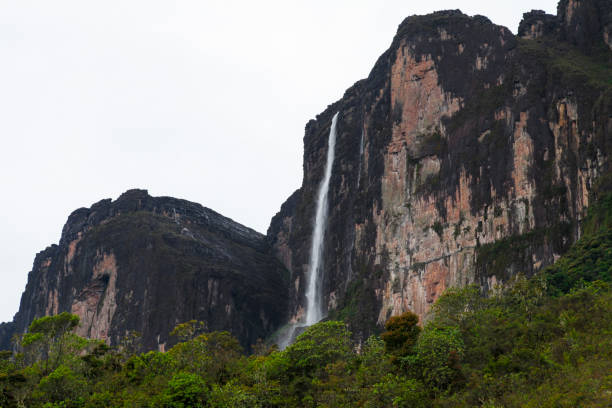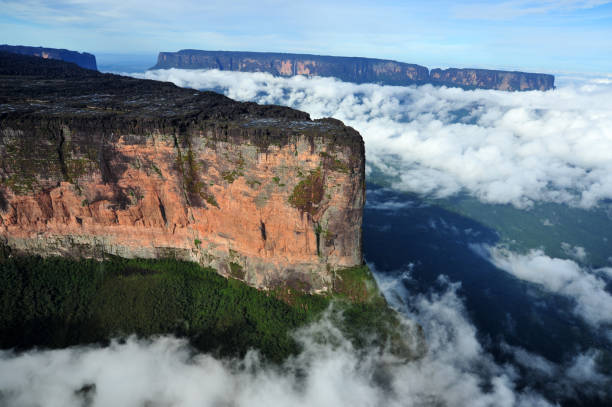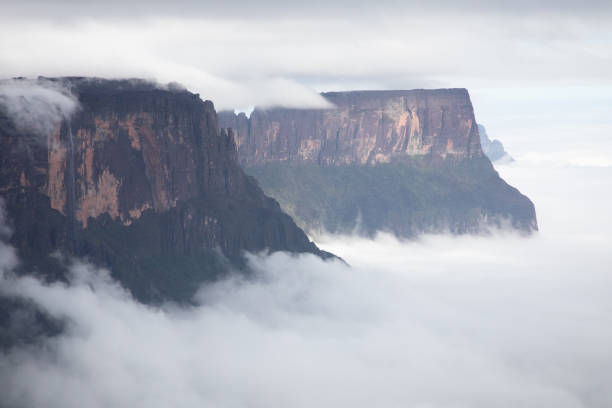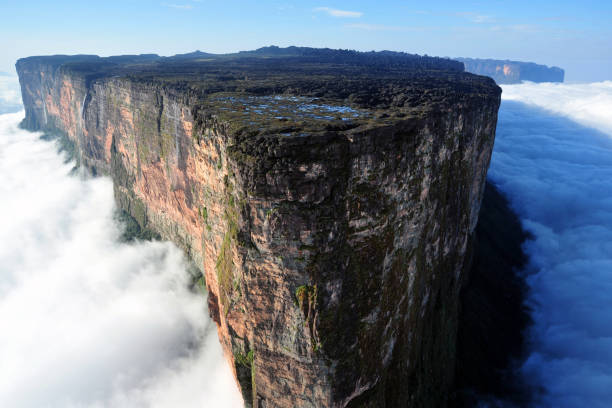
Have you ever wondered about the place where the earth meets the sky, where reality intertwines with fantasy? Welcome to the enigma that is Mount Roraima. This geographical wonder stands tall and majestic, straddling the borders of not one, but three countries: Venezuela, Brazil, and Guyana. Characterized by its unique, flat summit, this massive mountain plateau starkly contrasts with the stereotypical peak often associated with mountains. The summit stretches out like an endless canvas, a silent sentinel watching over the lush landscapes below.
But it’s not just the magnitude and unusual topography that make Mount Roraima fascinating. It’s the air of mystery that cloaks it, a mystical atmosphere that seems to whisper tales of the unknown. It’s a place that sparks curiosity, begs to be explored, and challenges the boundaries of our understanding—a place where the impossible seems to become possible.
Mount Roraima, a geological masterpiece, stands tall at 2,810 meters, dominating the landscape of the Guiana Highlands. It’s a majestic natural fortress, its imposing presence accentuated by steep cliffs that rise sharply, almost vertically, from the dense rainforest below. These cliffs, some reaching a staggering 400 meters in height, form the vertical walls of this towering plateau. The heart of Mount Roraima, however, is its unique flat summit, stretching over thirty-one square kilometers. Unlike the pointed peaks of most mountains, Roraima’s summit is a vast, desolate plain, punctuated by eerie rock formations and interspersed with shallow pools of water. This flat top is largely due to millions of years of erosion by wind and water, carving this tabletop shape that Roraima is so renowned for.

It’s not just the physical shape that sets Mount Roraima apart. It’s home to an ecosystem as unique as its geography. The upper plateau, cut off from the world below, has allowed distinct species of plants and animals to evolve in isolation, creating a living laboratory of evolution. The weather on Mount Roraima is as peculiar as its landscape. The mountain is no stranger to rainfall, with showers occurring almost daily. This frequent rain, combined with the mountain’s high altitude, often results in a dense, misty aura that envelops the mountain, adding to its mystique. It’s not uncommon for trekkers to find themselves walking through clouds, an experience as surreal as it is breathtaking.
Perhaps the most striking feature of Mount Roraima’s weather is the constant interplay of sun, rain, and mist. It’s a place where you can bask in the warmth of the sun, feel the coolness of the rain, and get lost in the fog, all within a single day. A place of spectacular beauty, Mount Roraima is a testament to nature’s power and mystique. It’s a world within a world, a place where every rock, every creature, and every droplet of rain tells a story—a story of resilience, survival, and the enduring power of nature’s creativity.
Mount Roraima, a unique ecosystem, harbors a world of life on its high plateau. This is not just a mountain; it’s a living, breathing entity, home to an array of flora and fauna that have beaten the odds to thrive in this challenging environment. Among the many species, the most captivating are perhaps the carnivorous plants. These unique species have adapted to the nutrient-poor soils by developing the ability to trap and digest insects. The sun pitcher plant, with its vibrant colors and distinct shape, is a prime example. It lures unsuspecting insects into its deadly trap using a sweet nectar. Once trapped, the insects slowly dissolve, providing the plant with the nutrients it needs to survive.

Mount Roraima is also a sanctuary for a variety of orchids and bromeliads, some of which are found nowhere else in the world. These resilient plants, with their varied hues and delicate blossoms, add a touch of beauty to the rugged landscape. But it’s not just about the plants. This mountain also hosts a variety of creatures that have learned to survive in its harsh environment. Among them, the Roraima black frog stands out. This tiny amphibian, unique to the tepuis of South America, has adapted to the cold, wet conditions of the plateau. It lives among the rocks and crevices, feeding on insects and staying clear of the predatory birds that roam the skies above.
Then there are the birds. From the tiny hummingbirds, flitting from flower to flower, to the majestic raptors soaring high above the plateau, each species adds its own unique charm to the ecosystem of Mount Roraima. Let’s not forget the myriad of insects, from colorful butterflies to industrious ants, that contribute to the biodiversity of this unique environment. Each creature, no matter how small, plays a crucial role in maintaining the delicate balance of this ecosystem.
Mount Roraima, a haven of life amidst harsh conditions, is a living testament to nature’s resilience. This majestic mountain, with its unique flora and fauna, stands as a beacon of life’s ability to adapt, survive, and even thrive against all odds. Wrapped in mystery and steeped in legend, Mount Roraima has captivated the minds of explorers and scientists alike. This isn’t just a mountain; it’s a living, breathing entity, intertwined with the cultures and beliefs of those who live in its shadow.

The indigenous people of the region, the Pemon and Kapon, have revered Mount Roraima as a sacred entity for centuries. In their lore, it’s known as ‘Roroi-ma,’ meaning ‘great blue-green.’ They believe it to be the stump of a mighty tree that once bore all the fruits and vegetables in the world. According to their mythos, when Makunaima, their trickster god, chopped down the tree, it led to a catastrophic flood, and the remaining stump became Mount Roraima. But the mysteries of this mountain aren’t confined to the realm of myths and legends.
Scientists, too, have been intrigued by its unique geographical features. The flat summit of Mount Roraima, which spans over thirty square kilometers, is unlike most mountains and has puzzled geologists for years. This tabletop mountain is one of the oldest geological formations on Earth, dating back nearly two billion years. One of the most fascinating aspects is the unique ecosystem that thrives on the plateau. Isolated for millions of years, the plateau has given rise to a plethora of unique species of plants and animals that can’t be found anywhere else in the world. This has led to the area being dubbed a ‘Lost World,’ a place where evolution has taken a path all of its own.
The mountain’s sheer cliffs and treacherous weather conditions have also been a source of fascination and fear. These elements have created a natural fortress, making it one of the least explored places on Earth. Mount Roraima, a place where reality and fantasy intertwine, continues to beckon the curious and the adventurous. Whether it’s the lure of its ancient legends, the intrigue of its scientific enigmas, or the challenge of its formidable terrain, this mountain continues to inspire awe and wonder in all who dare to venture its way.